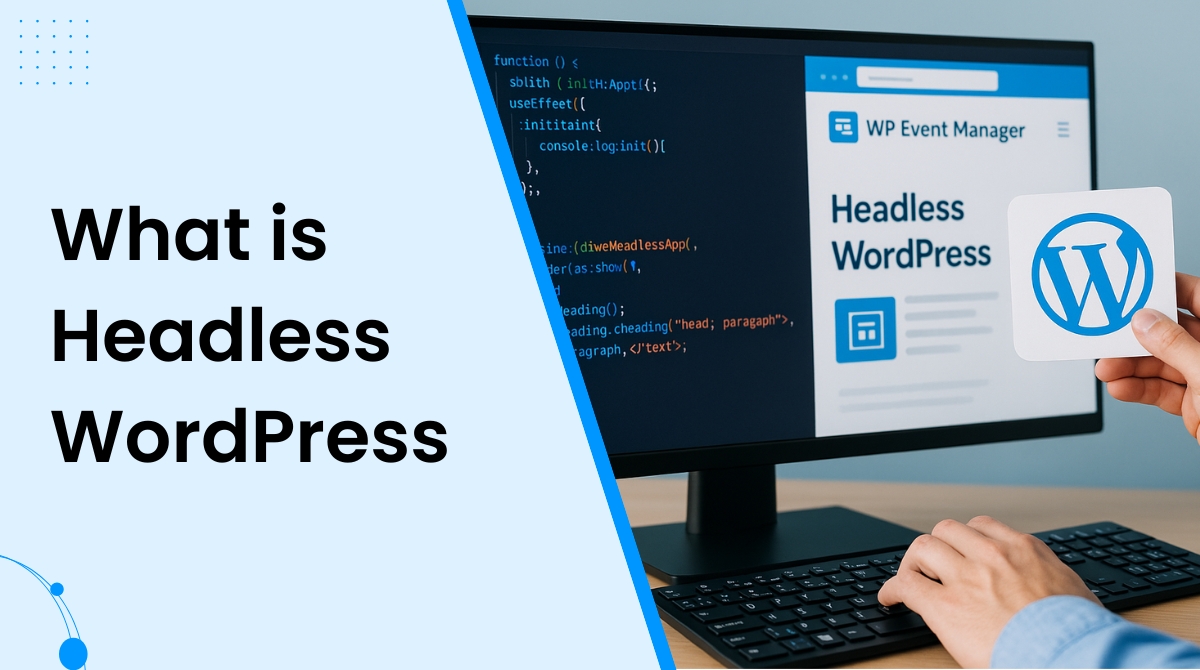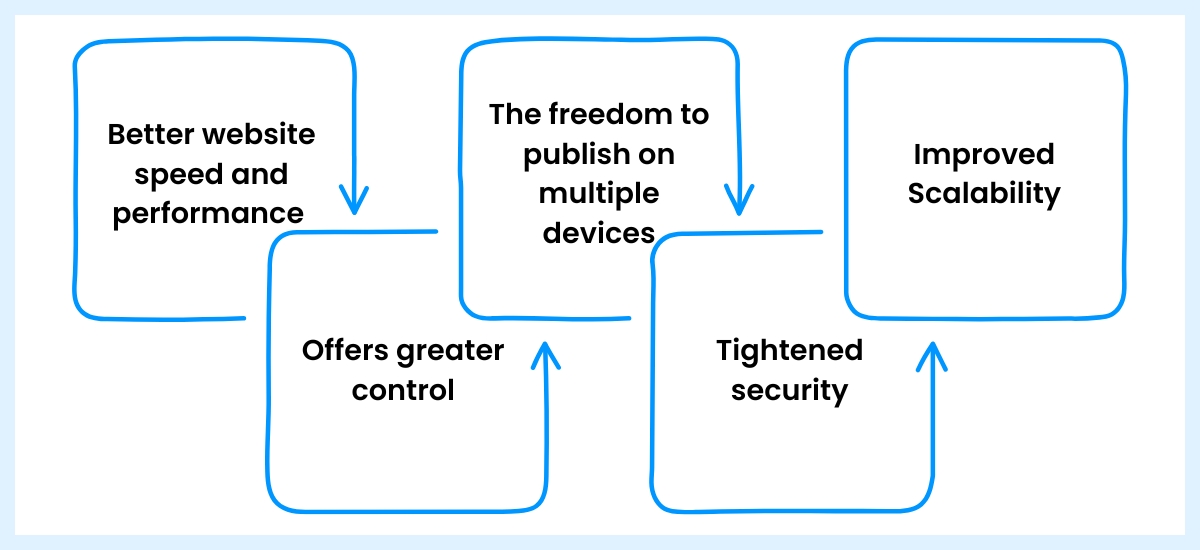Headless WordPress is the hottest new web development trend that developers are following to achieve well-designed, fast, and secure websites.

Keeping pace with the latest technical advancements often becomes a challenge for content creators and developers. That is where the role of a Headless Content Management System (CMS) takes center stage. It offers an easily adaptable backend content management system and the freedom to manage how the content appears on the website.
The difference between the traditional and modern headless WordPress CMS lies in their architecture. In the conventional WordPress setup, the backend and frontend are coupled and operated through a single application, whereas the headless WordPress decouples the content management system(backend) from the presentation layer(frontend).
In this article, we have shared a detailed guide on headless WordPress, its pros and cons, and why you should use it.
What is headless CMS?
A headless CMS refers to a backend-based content management system, primarily used for content creation, management, and storage. It utilizes APIs to display content on digital channels like mobile apps, websites, etc. It follows the principle of “create once, publish anywhere,” which offers versatility for developers and allows them to deliver multi-channel content with improved user experience.
In simple words, a headless CMS system lets users manage all content in one place and deploy it on any of their preferred digital channels, like a website, mobile app, etc.
Decoupling the backend from the frontend frees the content, which enables marketers to handle the content independently without backend intervention. Similarly, it also helps developers create things faster, automate changes, and handle the digital space with ease.
What is headless WordPress?
Headless WordPress is often referred to as a monolithic CMS, where data and content are managed at the backend, and a completely separate technology is used to display them at the frontend. In the headless WordPress architecture, WordPress does not generate HTML web pages to display to visitors. The delivery and representation of your content at the frontend depends on different software.
Such software for the frontend management includes static site generators like Gatsby, Next.js, or Hugo and more. Besides them, it can also be managed by a JavaScript framework such as React.js, Vue.js, js etc. Customized frontend-based webpages can also be created with them.
Headless WordPress benefits
Being one of the most popular WordPress web development trends, headless WordPress brings multiple benefits which are discussed in detail.

1. Better website speed and performance
According to developers, headless WordPress helps create faster websites. Unlike traditional WordPress themes, it delivers content using APIs to advanced frontend tools like Vue, React or Next.js, which are designed for speed.
The decoupled setup eliminates the use of unnecessary code, speeds up loading time and enables developers to use CDN integration, lightweight designs, and advanced caching, which improves website speed.
2. Offers greater control
One of the biggest advantages of the headless WordPress architecture is that it allows developers the ultimate freedom to design the website frontend without relying on WordPress themes and plugins. As the content is delivered using APIs, it can be represented on multiple digital platforms, including websites, apps, and IoT devices, with the help of any technology stack. Using the headless WordPress architecture, businesses can easily maintain branding, improve user experience while enjoying the advantages of the powerful backend of the WordPress CMS.
3. The freedom to publish on multiple devices
The headless WordPress setup allows developers to post their content on multiple devices, as it supplies content through APIs that can be used on various platforms. The best part is that they can use the same content on the website, social media channels, mobile apps or any other smart digital devices without the issue of duplication. It not only saves time for content makers but also helps them expand their audience reach with a single piece of content.
4. Tightened security
Another remarkable advantage of headless WordPress is security. As it separates the frontend from the backend completely, frontend users do not get access to the backend. This automatically reduces the risk of common vulnerabilities like misusing the plugins and themes. As the content is completely dependent on APIs, it can be strictly managed and tracked, offering better security to businesses against threats and malicious attacks.
5. Improved Scalability
Headless WordPress offers better scalability to businesses which is also considered as a big advantage of using it. It empowers businesses with the ability to manage heavy traffic and content demands by separating the backend from the frontend. This helps them scale each side as required, starting from handling a huge number of users to multiple platforms and advanced technology integration.
Now that you know about the advantages of the headless WordPress architecture, let us discuss the disadvantages of using it.
Disadvantages of Headless WordPress
Just like any other software or technology, besides advantages, the headless WordPress architecture also comes with some disadvantages. Let us discuss them all in detail.

1. Cost
The first thing that comes to mind while discussing the disadvantages of the headless WordPress architecture is its cost. It is a more expensive option than the traditional setup. This is because with headless WordPress, you need to bear the cost of hiring developers for website frontend operations. Even if you are a developer or use a frontend development framework, you need to spend a significant amount of time and effort to prepare it properly.
2. Some plugins may not support
Plugins are a crucial part of a WordPress website for feature enhancement. However, some of the WordPress plugins do not work well with the headless WordPress architecture. These are the plugins that depend on frontend rendering, including sliders, forms, page builders etc. To use them in headless WordPress, custom integration is required.
3. Maintenance issues
As the frontend and backend are decoupled from each other in headless WordPress, you need to maintain them both separately for which you need to appoint developers, especially if the complexity increases or a problem occurs.
Why you should use headless WordPress?
Using the headless WordPress architecture means making your website content future-ready at least till the time the API endpoint is active. It gives you the advantage of creating a developer-friendly, API-first system, instead of paying attention to how the backend operations will represent the frontend design.
As a developer, you can experience more flexibility in shifting your content to any digital platform whenever needed without restricting it to specific themes and plugins. In addition to that, you can also create a personalized customer experience without much effort with headless WordPress.
This could be an amazing option for those who want to use their content on both IOS and Android platforms with the same platform.
Who Should Use Headless WordPress?
Just because headless WordPress is one of the most popular WordPress development trend, you do not need to use it. This is because the headless WordPress architecture is not suitable all purposes. Before finalizing your decision to use it, you need to properly check if you truly need it. For example, if your company requires a custom website or an application with simplified content handling features, then using a headless WordPress architecture can be really helpful.
Your overall budget and skills should also be taken into consideration because if you are using the new WordPress, then you might need to hire developers or else you need to have development skills to manage the platform smoothly.
Always keep in mind that a headless WordPress CMS is suitable only when you need to create a custom WordPress site or app with robust content creation and management features.
Things to consider about the Headless WordPress CMS
- Business owners with limited technical knowledge may find it difficult to determine if their business needs a headless WordPress or not.
- If your developers recommend the new setup, make sure you ask them about the advantages and improvements you can expect with that.
- It is a fact that adopting the new technology will make negligible improvements to your website, and the cost of creating a brand new one and maintaining it is also high.
In the end, we need to keep in mind that the Headless WordPress CMS have both pros and cons just like any other system. That is why you need to thoroughly evaluate your requirements and the setup before finalizing it.
The post What is Headless WordPress: A Complete Guide for 2025 appeared first on WP Event Manager.
0 Commentaires